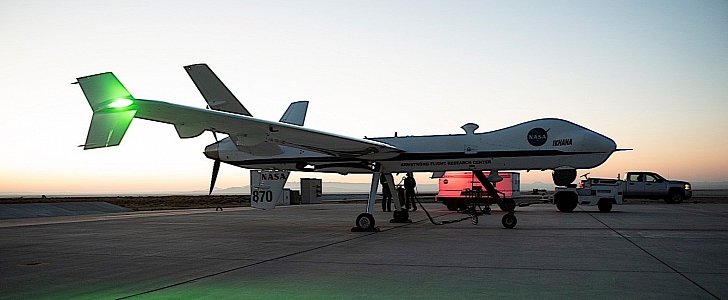NASA’s airborne platform Ikhana performed this week its first unaccompanied test flight in the same airspace used by commercial aircraft, marking a major breakthrough for the agency and its research into long-duration Earth observation.
Based on a Predator B General Atomics drone, the Ikhana was up until know accompanied by what is known as a chase airplane. In case of drones flying over controlled air space, the Federal Aviation Administration (FAA) stipulates an accompanying aircraft is to observe the behavior of the unmanned one for safety reasons.
After receiving a special permission from the FAA, the drone took off from Edwards Air Force Base in California and flew west, at an altitude of about 20,000 feet. It then headed north toward Fresno and then back south toward Victorville.
For the duration of the flight, the ground-based pilot of the drone was in contact with air traffic control operators in Los Angeles and Oakland.
Aside for the flight being monitored by air traffic control, a host of other flight-safety technologies were put through its paces. For the test, the Ikhana was equipped with an airborne radar, Traffic Alert and Collision Avoidance System, and a Detect and Avoid Fusion Tracker.
An Automatic Dependent Surveillance-Broadcast capability was also turned on for the duration of the flight, allowing the drone to determine its position and broadcast it so other aircraft can track it.
“We are flying with a suite of sophisticated technology that greatly enhances the safety capabilities of pilots flying large unmanned aircraft in the National Airspace System,” said Scott Howe, the drone’s test pilot.
“We took the time to mitigate the risks and to ensure that we, as a program, were prepared for this flight.”
Conducting a real flight with no chase aircraft is a step forward towards normalizing unmanned aircraft operations in the airspace used by commercial planes. NASA says this technology would help, at first, to monitor and fight forest fires or to provide emergency search and rescue operations.
Further applications derived from the technologies tested on the drone, like freight or even passenger transport, are not excluded.
After receiving a special permission from the FAA, the drone took off from Edwards Air Force Base in California and flew west, at an altitude of about 20,000 feet. It then headed north toward Fresno and then back south toward Victorville.
For the duration of the flight, the ground-based pilot of the drone was in contact with air traffic control operators in Los Angeles and Oakland.
Aside for the flight being monitored by air traffic control, a host of other flight-safety technologies were put through its paces. For the test, the Ikhana was equipped with an airborne radar, Traffic Alert and Collision Avoidance System, and a Detect and Avoid Fusion Tracker.
An Automatic Dependent Surveillance-Broadcast capability was also turned on for the duration of the flight, allowing the drone to determine its position and broadcast it so other aircraft can track it.
“We are flying with a suite of sophisticated technology that greatly enhances the safety capabilities of pilots flying large unmanned aircraft in the National Airspace System,” said Scott Howe, the drone’s test pilot.
“We took the time to mitigate the risks and to ensure that we, as a program, were prepared for this flight.”
Conducting a real flight with no chase aircraft is a step forward towards normalizing unmanned aircraft operations in the airspace used by commercial planes. NASA says this technology would help, at first, to monitor and fight forest fires or to provide emergency search and rescue operations.
Further applications derived from the technologies tested on the drone, like freight or even passenger transport, are not excluded.




